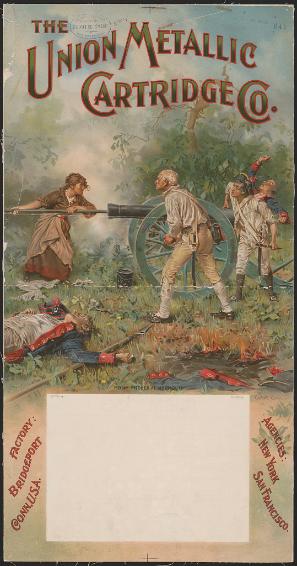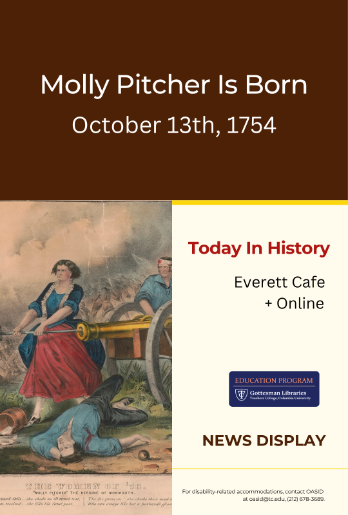Today In History: Molly Pitcher Is Born

One of Molly's strong characteristics, exhibited in many and various ways, was her readiness to help others in times of need. Opportunity was all that was necessary. She was intensely interested in the war. A warm patriot and a warmer hater of the redcoats, she could not see the poor soldiers in the heat and dust of battle suffering from thirst, without exposing her own life, if necessary, in their relief. How grateful must Molly's "pitcher" been to those thirsting men, and how astonishing her bravery, as she seized the rammer and worked like a Amazon to save her husband's gun. She was dubbed "sergeant," by the soldiers and was also called "Major Molly."
-- John Landis, From "Molly Takes Her Husband's Place as Gunner", A Short History of Molly Pitcher, the Heroine of the Battle of Monmouth.
Molly Pitcher, otherwise Mary Ludwig Hays, was a Revolutionary War heroine recognized for her valiant efforts in bearing water to soldiers and also loading the cannon during the Battle of Monmouth in 1778. Believed to be born on October 13th, 1754 in Trenton, New Jersey, Mary, nicknamed Molly, was the daughter of dairyman John George Ludwig and likely of Irish-German descent. At the age of 15, she became a domestic in the household of physician William Irvine and his wife and Ann of Carlisle, Pennsylvania. There Mary met a young barber by the name of William Hays, who in 1777 closed up his shop and set off for Valley Forge, Pennsylvania, to join the fight for independence.
Mary, an ardent supporter, went with him. When her husband collapsed from heat exhaustion in Monmouth on a hot and humid June 28th, 1778, she bravely took it upon herself to tend to all the thirsty soldiers, and anonymously stationed herself at the cannon, taking William's place. Following the retreat of the British and impressed by her actions, General George Washington sought Mary Hays' identity, and proudly issued her a warrant as a non-commissioned officer. As "Sergeant Molly" she was unofficially known.
"Molly Pitcher" grew to a generic term, representing all women who served in military capacity, whether they helped stock and carry ammunition or actually fired guns in battle. Soldiers that fought in the Battle of Monmouth -- the last battle of the Philadelphia Campaign and a strategic victory for the Americans in holding the battlefield -- remembered the brave woman who assisted them. Although it's not known if she partook in other battles before the war ended in 1783, Molly Pitcher's story became a beloved part of the history of the founding of the new strong nation and an inspiration for women in decades to come.
The following articles are drawn from Proquest Historical Newspapers, which informs and inspires classroom teaching and learning.
- Molly Pitcher's Grace: No Stone Marks the Last Resting Place of the Revolutionary Heroine. (1894, Jan 28). The Washington Post (1877-1922)
- 125 Years Since "Molly Pitcher" Fire Her Cannon. (1903, Jul 05). Courier-Journal (1869-1922)
- "Molly Pitcher": Woman Who Was Honored as a Revolutionary Heroine. (1906, Dec 05). New - York Tribune (1900-1910)
- [Boston Globe.]. (1914, Dec 06). Women Have Fought in Wars: Boadicka, Joa of Arc, Molly Pitcher Among Many Who Are Famous for Heroism in Battle. The Washington Post (1877-1922)
- Molly Pitcher Was Born 172 Years Ago. (1916, Nov 12). The Sun (1837-)
- Stuyvesant, M. (1922, Aug 11). Heroines of History: Significant Incidents in the livesof Famous Women: How Molly Pitcher Helped Win the Battle of Monmouth. St.Louis Post - Dispatch (1879-1922)
- Chicago Stands Results in Suit: Historian Asks Damages of Mayor's Investigator: Textbook Writer Resents Pro-British Charges: Pictures of Molly Pitcher Deleted in Schools. (1927, Dec 08). Los Angeles Times (1923-1995)
- James E. Kelly Dies; Sculptor of Monuments: Did Figures of Washington for Valley Forge Memorial and Sub-Treasury Steps: Edison Often His Model Posed as Gunner at Base of Molly Pitcher Monument. (1933, May 27). New York Herald Tribune (1926-1962)
- Molly Pitcher Predicted Boston's Great Growth. (1938, Dec 11). Daily Boston Globe (1928-1960)
- Faries, B. (1978, Apr 23). Collections; A Card for Molly Stamps. Boston Globe (1960-) Retrieved from
- Kannapell, A. (1997, Dec 07). Did Molly Pitcher Stop Here? New York Times (1923-)

Tips:
- Cunningham, Mark. Molly Pitcher - The Woman Who Fought the War. 1st ed., Cavendish Square Publishing LLC, 2014. e-book.
- Fedyszyn, Kirra. Molly Pitcher. PowerKids Press, 2015. e-book.
- Landis, John B. A Short History of Molly Pitcher, the Heroine of the Battle of Monmouth / [by John B. Landis]. Together with an Account of the Ceremonies Incident to the Unveiling of the Cannon Planted over Her Grave in the Old Graveyard in Carlisle, Pennsylvania, by the Patriotic Order of Sons of America, on June 28, 1905. Cornman Print. Co. for the District of Cumberland County P.O.S. of A. of Pennsylvania, 1905, 1905. e-book.
- McDonnell, Michael A., et al. Remembering the Revolution: Memory, History, and Nation Making from Independence to the Civil War. Edited by W. Fitzhugh Brundage et al., 1st ed., University of Massachusetts Press, 2013. e-book.
- Rockwell, Anne F., and Cynthia Von Buhler. They Called Her Molly Pitcher. First edition., Alfred A. Knopf, 2002. Curriculum ; E241.M7 R63 2002.
Images:
- Gaul, Gilbert William, Artist. The Union Metallic Cartridge Co., "Molly Pitcher at Monmouth" / Gilbert Gaul. United States, ca. 1897. Dec. 22. Photograph. Courtesy of Library of Congress.
- Poster Image: Currier & Ives. The Women of '76: "Molly Pitcher" the Heroine of Monmouth. Freehold United States New Jersey, None. [New York: Published by Currier & Ives, between 1856 and 1907] Photograph. Courtesy of Library of Congress.

